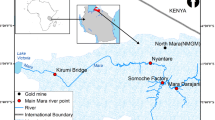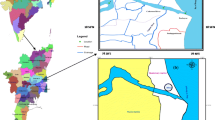Abstract
The identification of contamination level and ecological risks, associated with heavy metal pollution of sediments in small hydropower cascade was done on the base of index analyses approach. The concentration of As, Cd, Cu, Hg, Pb, Zn, total organic carbon and percentage of fines were determined in sediments of two habitats in cascade sequence – river and dam. Correlation and multivariate analyses suggest that As, Cu, Pb and Zn are associated with similar anthropogenic source. Cadmium and mercury originate from different source and have specific moving. Based on the contamination and background indices the sediments in Middle Iskar cascade are moderate contaminated at least and are subject of intensive hydrological and technological mixing. The potential ecological risk index (PERI) classifies the sediments in dam site with the higher risk level. Suitable indicators for express assessment of metal pollution in “river” sediments are contamination/enrichment indices which are more sensitive for local concentration increase of less toxic metals. In “dam” sites the process of sedimentation affects strongly the degree of metals accumulation and differences in toxicity are clearly presented – PER/PERI in combination with content of fine sediment fractions and TOC have a potential for rapid identification of sediment-associated risks.



Similar content being viewed by others
References
Anderson D, Moggridge H, Warren P, Shucksmith J (2014) The impacts of ‘run-of-river’ hydropower on the physical and ecological condition of rivers. Water Environ J. doi:10.1111/wej.12101
ASTAE - Asia Sustainable and Alternative Energy Program (2014) Cumulative Impacts and Joint Operation of Small-Scale Hydropower Cascades. South Asia Energy Studies. Washington, DC: World Bank
Barlas N, Akbulut N, Aydogan M (2005) Assessment of heavy metal residues in the sediment and water samples of Uluabat Lake, Turkey. Bull Environ Contam Toxicol 74:286–293
Bryan GW, Langston WJ (1992) Bioavailability, accumulation and effects of heavy metals in sediments with special reference to United Kingdom estuaries: a review. Environ Pollut 76(2):89–131
Caeiro S, Costa MH, Ramos TB (2005) Assessing heavy metal contamination in Sado estuary sediment: an index analysis approach. Ecol Indic 5:151–169
Cao F, Ge Y, Wang JF (2013) Optimal discretization for geographical detectors-based risk assessment. GISci Remote Sens 50(1):78–92
Cholakova Z (2004) Geochemical peculiarities of migration and concentration of some heavy metals in the Iskar River basin in Stara Planina Mountain. In: First international conference human dimensions of global change. April, Sofia, Bulgaria, pp. 22–24
Farnham IM, Johannesson KH, Singh AK, Hodge VF, Stetzenbach KJ (2003) Factor analytical approaches for evaluating groundwater trace element chemistry data. Anal Chim Acta 490:123–138
Ferreira AR, Teegavarapu RSV (2012) Optimal and adaptive operation of a hydropower system with unit commitment and water quality constraints. Water Resour Manag 26:707–732
Fiori CS, Rodigues APC, Santelli RE, Cordeiro RC, Carvalheira RG, Araujo PC, et al. (2013) Ecological risk index for aquatic pollution control: a case study of coastal water bodies from the Rio de Janeiro state, southeaster Brazil. Geochim Bras 27(1):24–36
Fu J, Zhao C, Luo Y, Liu C, Kyzas GZ, Luo Y, et al. (2014) Heavy metals in surface sediments of the Jialu River, China: their relations to environmental factors. J Hazard Mater 270:102–109
Gao BB, Wang JF, Fan HM, Xu K, Hu MG, Chen ZY (2015) A stratified optimization method for a multivariate marine environmental monitoring network in the Yangtze River estuary and its adjacent sea. Int J Geogr Inf Sci 29(8):1332–1349
Goyal MK, Singh V, Meena AH (2015) Geospatial and hydrological modeling to assess hydropower potential zones and site location over rainfall dependent inland catchment. Water Resour Manag 29:2875–2894
Hakanson L (1980) Ecological risk index for aquatic pollution control. A sedimentological approach. Water Res 14:975–1001
Hammer Ø, Harper DAT, Ryan PD (2001) PAST: paleontological statistics software package for education and data analysis. Palaeontol Electron 4(1):9
Hu WW, Wang GX, Deng W, Li SN (2008) The influence of dams on ecohydrological conditions in the Huaihe River basin, China. Ecol Eng 33:233–241
Jablonskis J, Jurgelenaite A, Tomkevičiene A. (2008) Lithuanian hydropower and environment protection. In: 7th International Conference on Environmental Engineering, May 22–23,Vilnius, Lithuania. Selected papers 2:557–562
Kenderov L, Yaneva I (2009) Ecological characteristics of the Iskar River catchment. Biotech Biotechnol Eq. 23(sup1):276–280
Lacerda LD, Fernandez MA, Calazans CF, Tanizaki KF (1992) Bioavailability of heavy metals in sediments of two coastal lagoons in Rio de Janeiro, Brazil. Hydrobiologia 228(1):65–70
Lincheva S, Todorova Y, Topalova Y (2014) Long-term assessment of the self-purification potential of a technologically managed ecosystem: the middle Iskar cascade. Biotech Biotechnol Eq 28(3):455–462
Malmqvist B, Rundle S (2002) Threats to the running water ecosystems of the world. Environ Conserv 29:134–153
Mihailova P, Traykov I, Tosheva A, Nachev M (2013) Changes in biological and physicochemical parameters of river water in a small hydropower reservoir cascade. Bulg J Agric Sci 19(2):286–289
Ministry of Environment and Water, Ministry of Health, Ministry of Agriculture and Food, Bulgaria (2008) Regulation No 3 of 1 August 2008 on standards for admissible harmful substances in soils
Muller G (1969) Index of geoaccumulation in sediments of the Rhine River. Geo J 2:108–118
Muller G (1981) Die Schwermetallbelstung der sedimente des Neckarsund seiner Nebenflusse: eine Bestandsaufnahme. Chemiker-Zeitung 105:157–164
Pasha MFK, Yeasmin D, Rentch JW (2015) Dam-lake operation to optimize fish habitat. Environ Process 2:631–645
Ren Y, Deng L, Zuo S, Luo Y, Shao G, Wei X, Hua L, Yang Y (2014) Geographical modeling of spatial interaction between human activity and forest connectivity in an urban landscape of Southeast China. Landsc Ecol 29(10):1741–1758
Santos BJC, Beltran R, Gomez AJL (2003) Spatial variations of heavy metals contamination in sediments from Odiel River (Southwest Spain). Environ Int 29:69–77
Singh PK, Kumar V, Purohit RC, Kothari M, Dashora PK (2009) Application of principal component analysis in grouping geomorphic parameters for hydrologic modeling. Water Resour Manag 23:325–339
Todorova Y, Yotinov I, Lincheva S, Topalova Y (2015) A large-scale identification of sediment-associated risks of contamination with heavy metals and organics: indicators and algorithms. J Water Resour Prot 7:101–110
US EPA (2002) A Guidance Manual to Support the Assessment of Contaminated Sediments in Freshwater Ecosystems. Volume III - Interpretation of the Results of Sediment Quality Investigations. United States Environmental Protection Agency, Washington, DC, EPA-905-B02–001-C
US EPA (2007) Method 3051a: microwave assisted acid dissolution of sediments, Sludges, soils, and oils, revision 1. United States Environmental Protection Agency. Washington, DC
Vaikasas S, Lamsodis R (2011) Sediment and nutrient retention in reservoirs of small hydropower plants. In: 8th International Conference on Environmental Engineering, May 19–20 Vilnius, Lithuania. Selected papers:684–691
Varol M (2011) Assessment of heavy metal contamination in sediments of the Tigris River (Turkey) using pollution indices and multivariate statistical techniques. J Hazard Mater 195:355–364
Wang JF, Li XH, Christakos G, Liao YL, Zhang T, Gu X, Zheng XY (2010) Geographical detectors-based health risk assessment and its application in the neural tube defects study of the Heshun region, China. Int J Geogr Inf Sci 24(1):107–127
Warner RF (2012) Environmental impacts of hydroelectric power and other anthropogenic developments on the hydromorphology and ecology of the durance channel and the Etang de Berre, Southeast France. J Environ Manag 104:35–50
World Energy Council: Water for Energy (2010) London, United Kingdom ISBN 978–0–946121-10-6; http://www.worldenergy.org/publications/2010/water-for-energy-2010/
Wu J, Zeng H, Yu H, Ma L, Xu L, Qin B (2012) Water and sediment quality in lakes along the middle and lower reaches of the Yangtze River, China. Water Resour Manag 26:3601–3618
Yi YJ, Yang ZF, Zhang SH (2011) Ecological risk assessment of heavy metals in sediment and human health risk assessment of heavy metals in fishes in the middle and lower reaches of the Yangtze River basin. Environ Pollut 159:2575–2585
Zhai H, Cui B, Hu B, Zhang K (2010) Prediction of river ecological integrity after cascade hydropower dam construction on the mainstream of rivers in longitudinal range-gorge region (LRGR), China. Ecol Eng 36(4):361–372
Zhu H, Yuan X, Zeng G, Jiang M, Liang J, Zhang C, et al. (2012) Ecological risk assessment of heavy metals in sediments of Xiawan port based on modified potential ecological risk index. Trans Nonferrous Metals Soc China 22:1470–1477
Acknowledgments
The authors gratefully acknowledge the PVB Power Bulgaria and VEC Svoge for their long-standing support. The authors thank Assoc. Prof. R. Nikolaeva, PhD, L. Kenderov, PhD and E. Daskalova for their valuable contribution for this work. Comments by the anonymous reviewers also improved the presentation of this paper.
Author information
Authors and Affiliations
Corresponding author
Ethics declarations
Conflict of Interest
The authors declare that they have no conflict of interest.
Rights and permissions
About this article
Cite this article
Todorova, Y., Lincheva, S., Yotinov, I. et al. Contamination and Ecological Risk Assessment of Long-Term Polluted Sediments with Heavy Metals in Small Hydropower Cascade. Water Resour Manage 30, 4171–4184 (2016). https://doi.org/10.1007/s11269-016-1413-8
Received:
Accepted:
Published:
Issue Date:
DOI: https://doi.org/10.1007/s11269-016-1413-8




